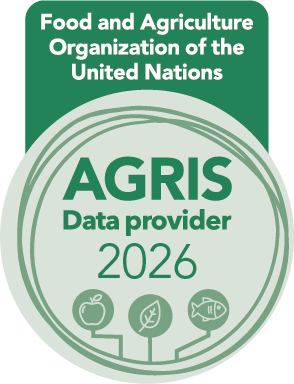Effect of seed soaking and drying on germination, growth andvigour of Macadamia (Macadamia integrifolia Maiden & Betche)
DOI:
https://doi.org/10.24154/jhs.v20i1.2429Keywords:
seed, soaking, drying, germination, growth, vigour, MacadamiaAbstract
Macadamia nut (Macadamia integrifolia) is among the world’s premium nuts and is gaining popularity in India due to its high market value. However, its germination is poor and slow owing to the presence of a hard seed coat, often delaying emergence for 5–6 months. The present study evaluated the effect of seed soaking and drying treatments on germination and early growth attributes. Seeds soaked for three days followed by oven drying at 40 °C for 18 hours exhibited significantly earlier germination (47 days) and higher germination percentage (88.13%) compared with the control. These treatments also enhanced seedling growth parameters, including plant height (16.16 cm), stem girth (0.47 cm), number of leaves per plant (11.22), fresh weight (10.73 g), dry weight (4.66 g), vigour index-I (1429.11 cm), and vigour index-II (411.40 g). Correlation analysis revealed that initiation of germination was positively associated with the time required for 50% and complete germination. Overall, soaking macadamia seeds for three days followed by oven drying improved germination efficiency, growth performance, and vigour of seedlings, and can be recommended for commercial propagation.
Downloads
References
Andrade, R. A. D., Martins, A. B. G., & Sarzi, I. (2002). Effect of temperature on percentage of germination of canistel seeds (Pouteria campechiana). Revista Brasileira de Fruticultura, 24(3), 622–623. https://doi.org/10.1590/S0100-29452002000300010
Bewley, J. D., & Black, M. B. (1982). Physiology and biochemistry of seed germination (Vol. II, p. 375). Springer Verlag.
Chiranjeevi, M. R., Muralidhara, B. M., Sneha, M. K., & Shivanand, H. (2017). Effect of growth regulators and biofertilizers on germination and seedling growth of Aonla (Emblica officinalis Gaertn). International Journal of Current Microbiology and Applied Sciences, 6(12), 1320–1326. https://doi.org/10.20546/ijcmas.2017.612.149
Garg, M. L., Blake, R. J., Wills, R. B., & Clayton, E. H. (2007). Macadamia nut consumption modulates favourably risk factors for coronary artery disease in hypercholesterolemic subjects. Lipids, 42(6), 583–587. https://doi.org/10.1007/s11745-007-3042-8
Hasanah, M., Sukarman, S., & Rusmin, D. (2002). Lack of effect of pretreatment on the viability of macadamia (Macadamia integrifolia) seed. Indonesian Journal of Agricultural Science, 3(2), 58–61. https://doi.org/10.21082/ijas.v3n2.2002.58-61
International Nut & Dried Fruit Council. (2021). Global macadamia market. Mordor Intelligence. https://www.mordorintelligence.com/industry-reports/global-macadamia-market
Lamichhane, S., Thapa, R., Thapa, P., & Ahamad, K. (2021). Effect of different pre-sowing treatments on germination of Persian walnut (Juglans regia L.) in Rukum district, Nepal. Turkish Journal of Agriculture - Food Science and Technology, 9(6), 1165–1171. https://doi.org/10.24925/turjaf.v9i6.1165-1171.4424
Masilamani, P., Yasodha, P., & Annadurai, K. (2013). Influence of seed pretreatments and sowing conditions on germination and initial seedling vigour of Indian almond (Terminalia catappa L.). Indian Forester, 139(3), 248–252.
Muralidhara, B. M., Reddy, Y. T. N., Srilatha, V., & Akshitha, H. J. (2016). Effect of seed coat removal treatments on seed germination and seedling attributes in mango varieties. International Journal of Fruit Science, 16(1), 1–9. https://doi.org/10.1080/15538362.2015.1021885
Muralidhara, B. M., Singh, R. S., & Veena, G. L. (2017). Effect of plant growth regulators and chemicals on seed germination of ker (Capparis decidua L.) and phalsa (Grewia subinaequalis). Progressive Horticulture, 49(1), 24–26. https://doi.org/10.5958/2249-5258.2017.00005.7
Muralidhara, B. M., Rajendiran, S., Madhu, G. S., Rani, A. T., Deekshith, D., & Mithun, P. M. (2023). Effect of pre-sowing treatments on germination, growth and vigour attributes of white sapote (Casimiroa edulis). Indian Journal of Agricultural Sciences, 93(6), 664–667. https://doi.org/10.56093/ijas.v93i6.136517
Penoni, E. D. S., Pio, R., Rodrigues, F. A., Maro, L. A. C., & Costa, F. C. (2011). Análise de frutos e nozes de cultivares de nogueira-macadamia. Ciência Rural, 41(12), 2080–2083. https://doi.org/10.1590/S0103-84782011001200007
Piza, P. L. B. D. T., & Moriya, L. M. (2014). Cultivo da macadamia no Brasil. Revista Brasileira de Fruticultura, 36(1), 39–45. https://doi.org/10.1590/0100-2945-444/13
Poinern, G. E. J., Senanayake, G., Shah, N., Thi-Le, X. N., Parkinson, G. M., & Fawcett, D. (2011). Adsorption of the aurocyanide, Au(CN)₂⁻ complex on granular activated carbons derived from macadamia nut shells – A preliminary study. Minerals Engineering, 24(15), 1694–1702. https://doi.org/10.1016/j.mineng.2011.09.011
Ricks, D. R. (1991). Functional natural oils. Cosmo and Tail, 106(2), 77–82.
Rusmin, D., & Hasanah, M. (1993). Perlakuan fisik dan kimia untuk menghilangkan kekerasan benih secang. Buletin Penelitian Tanaman Rempah dan Obat, 8(2), 108–110. https://repository.pertanian.go.id/handle/123456789/3761
Tripathi, P. C., Yogeesha, H. S., & Shetti, D. L. (2022). Standardization of propagation methods in minor wild fruit crops. Current Horticulture, 10(1), 32–36. https://doi.org/10.5958/2455-7560.2022.00006.1
Usha, D. S., Adivappar, N., Shivakumar, B. S., Thippesha, D., & Lakshmana, D. (2018). Evaluation of exotic macadamia (Macadamia spp.) genotypes for morphological and yield contributing traits. Journal of Farm Sciences, 31(5), 585–587.
Downloads
Published
Data Availability Statement
None
Issue
Section
License
Copyright (c) 2025 B M Muralidhara, Anuradha Sane, G Nayan Deepak, S Rajendiran, G S Madhu, A T Rani, D Deekshith, P M Mithun (Author)

This work is licensed under a Creative Commons Attribution-NonCommercial-ShareAlike 4.0 International License.
Authors retain copyright. Articles published are made available as open access articles, distributed under the terms of the Creative Commons Attribution-NonCommercial-ShareAlike 4.0 International License, which permits unrestricted non-commercial use, distribution, and reproduction in any medium, provided the original author and source are credited. 
This journal permits and encourages authors to share their submitted versions (preprints), accepted versions (postprints) and/or published versions (publisher versions) freely under the CC BY-NC-SA 4.0 license while providing bibliographic details that credit, if applicable.







 .
. 











